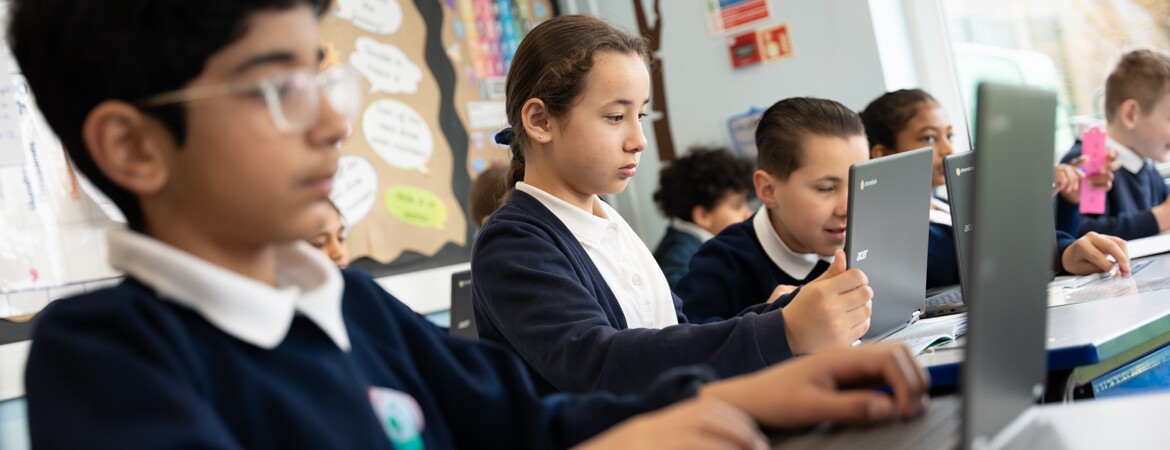How LEO Academy Trust Supports EAL Learning Through Technology
Back to News & Blogs
The number of EAL (English as an Additional Language) pupils has steadily increased over the past decade.
According to recent data, around 21% of pupils in reception are EAL learners and approximately 1.6 months behind their peers with English as a first language. In 2024, approximately 17,000 students entered the final two years of primary school with English as an additional language, 8.7 months behind their peers who speak English as a first language.
As a result, many schools across the country are facing the challenge of meeting the needs of a diverse student population with varying levels of English proficiency.
Guided by research and PedTech principles, we are doing our part to face this challenge head-on and ensure that no child in our classrooms is ever left behind.
Here is how LEO Academy Trust supports EAL pupils through technology for a truly accessible and equitable education.
What are the challenges of EAL learning?
The term ‘children with EAL’ refers to those who speak another language at home other than English. This includes both children who are British citizens who speak another language at home and migrants or refugees. Such broad classification means that there is significant variation in attainment outcomes within the EAL group, depending on factors like English language proficiency, earlier life experiences and arrival time to the English school system.
Regarding language proficiency, EAL students may struggle to understand the teacher’s instructions and the content of lessons, making it challenging for them to participate in class fully. Still, some students may be more advanced than others, making it difficult to meet the needs of all learners and deliver an education that truly challenges them.
When choosing effective technology tools to support EAL pupils, we consider:
-
Context – First, we need to ensure that the tools we use are helping with language in context. Simple support tools like dictionaries, and even more so digital picture dictionaries like Read&Write, deliver instant support and helpful context to new vocabulary.
-
Independence – We believe that technology should provide independence, whether we are using it as an accessibility tool for SEND learners or to support EAL pupils. LEO consistently chooses tools with a simple toolbar, so pupils can select what helps them most, creating a fully personalised resource for their language needs.
-
Translation – Finally, we consider tools that have inbuilt and intuitive translation facilities, which learners can choose to use or not use. For EAL learners with bigger language barriers, translation tools provide valuable help to build vocabulary and context.
EAL and PedTech at LEO Academy Trust
Census data shows that 39% of children at LEO schools speak English as an additional language (EAL), with the figure ranging from 13% to 63% depending on the school.
For children speaking another language at home, a whopping 98% reported a very positive experience of having their own Chromebook to use.
Notably, the schools with the highest proportion of EAL learners also had the strongest levels of appreciation for the Chromebook as a learning tool!
There are three main ways EAL children across LEO schools are able to leverage technology to meaningfully support their language and inclusion needs.
-
Translation and Context Tools
Children at LEO consistently use tools such as Google Translate, Everway (formerly Texthelp) and Nearpod to move seamlessly between English and their first language. We know that they value being able to choose when to use each language, as it helps them understand ideas in their first language before demonstrating their knowledge in English.
Commenting on how EAL-supporting technology has transformed their classrooms, LEO teachers said:
“Translation between learner and teacher and vice versa has made a huge difference. It has sped up the absorption of new language and given learners greater independence.”
“The ability to use apps like OrbitNote, Mote and Jamboard has allowed children with EAL and accessibility needs to participate fully in the curriculum.”
Other teachers note the creative use of Google Workspace, such as using Google Meet with closed captions and auto-translate to support a child who spoke no English at all, enabling them to follow lessons in real time and participate meaningfully.
-
Voice Recording and Metacognition
The Education Endowment Foundation defines Metacognition as the process of “learning to learn” through planning, monitoring and evaluating one’s work.
Metacognition is central to LEO’s teaching and learning strategy, and it has been implemented in classrooms through the use of Chromebooks.
Key Stage 1 children at LEO voice-record their ideas for writing, play them back, and check them against the success criteria, which gives them ownership of their work and encourages independence.
This process supports EAL learners and SEND learners alike in carefully reflecting on their ideas and becoming more confident in their abilities.
In addition, teachers note that EAL learners can use voice recording to first formulate ideas in their first language, then translate and share their work with the classroom.
-
Celebrating Culture
Children with EAL throughout LEO schools also use technology to share their knowledge and culture with their classmates, resulting in stronger friendships, more inclusive classrooms, and greater confidence in all EAL learners.
According to our latest report, over a third use their Chromebooks for personal cultural exchange projects, such as presentations on Lunar New Year or Japanese Pokémon. These activities give children the opportunity to showcase their cultural capital through images, video, auto-translate and other resources that are more familiar to them.
Using digital tools for inclusion and dignity
EAL learners are an increasingly significant part of our classrooms – and so is technology.
The LEO approach to EAL learning fosters a consistent culture of dignity, independence and empowerment, allowing learners from all EAL contexts to feel fully included in their classrooms by choosing the support that best suits their needs.
To learn more about LEO Academy Trust’s approach to PedTech and EAL learning, head over to our latest Impact Report!

